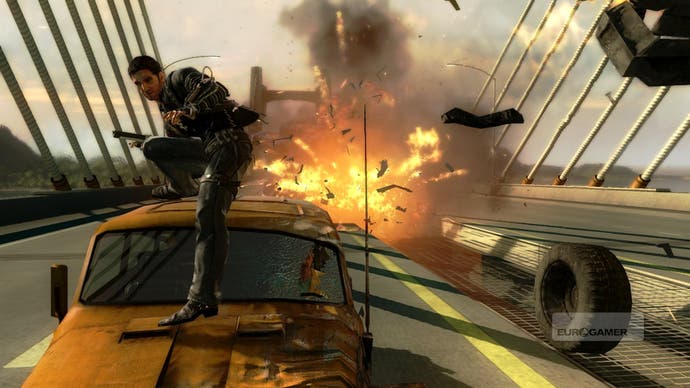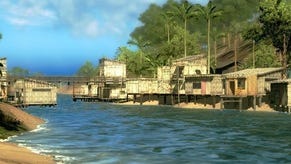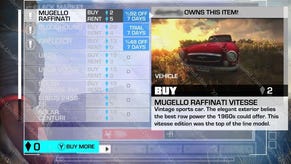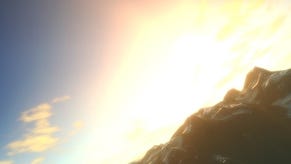Just Cause 2
Here and Panau.
If people like your game's basic mechanics, you might be onto a winner; if people like your game's bugs, you can't fail. Avalanche Studios should know: its first title, Just Cause, had some of the most likable glitches of all time, from an error which reduced the game's protagonist to a pair of invulnerable disembodied trousers, to supply drops which, when called in, would land directly on top of you.
Some bugs were annoying, of course (unless you were unfortunate enough to play it on the PS2, in which case they were actually fatal), but Just Cause still managed to get almost as much from the moments where its gears ground against one another as some games get out of the occasions when they mesh, and many of its unravellings could be forgiven because they were in-keeping with the overall tone, enhancing the joyous insanity that already characterised the adventures of Rico Rodriguez. They're not guaranteeing better bugs this time around, but it's promising to see Avalanche approaching the sequel by playing to the first game's strengths: conjuring up another source of extravagant destruction encumbered by only the merest flaming tatters of a plot.
Although his matinee looks and unforgiveable haircut suggest that Rico's destiny lies in the candle-lit bar of a Holiday Inn belting out Careless Whisper, he actually works in the heady world of geopolitics, destabilising states and taking out dictators through a mix of stunt-driving, parachuting, and, as previously discussed, occasionally assuming the accidental form of a pair of 38-inch slacks with an ironed-in crease. If the first Just Cause was a guilty pleasure, the sequel suggests a game that could be coming into its own. The setting has shifted - we're now on the South East Asian island of Panau, tackling a whole different manner of racial stereotypes - but the focus remains the same: blow everything up, shoot everybody you see, and never miss a chance to leap off a cliff and fling open your magic parachute.

At a recent developer playthrough, Avalanche was leaning heavily on the stats: Just Cause 2 features over 100 vehicles, ranging from cars through to jumbo jets, which you can use to explore any of 261 settlements, including one massive megacity, on an island that covers 1000 square kilometres. That's the same size as 252,840 football pitches, apparently - with the design team busy coming up with facts like that, it's not hard to see why they never got round to polishing the little details on the original game, like ensuring mission-critical garage-door checkpoints would always open as required. Equally, as anyone who's ever plodded through the surreal world of Boiling Point (another sandbox title that pitched itself on just how much space it covered) will tell you, big maps don't always mean big fun.
Happily, from what we've been shown, Just Cause 2 should have little trouble giving you something to do. Not only do detailed textures and stylish weather effects suggest this is shaping up to be a pretty game with a lot of visual variety (its island is carved into an implausibly varied ecosystem covering deserts, jungles, and frozen wastes), but it's centred on an environment populated by gun-crazed lunatics - a slapstick world in which you've been given a uniquely simple agenda.
While many sandbox games have struggled to balance freedom and narrative, giving you the tools to do almost anything before lining up missions that require rigid obedience, Just Cause 2 claims to revel in the collision, driving its story forward not just through specific objectives but by the Chaos System, which asks you to generally screw around causing trouble any way you can. The more you destabilise Panau, the more you progress the story, and Avalanche is suggesting that, should you want to, you'll likely be able to ignore most of faction missions and proceed through the main campaign just by trashing stuff.

In order to see this appealing agenda in action, the developer parachutes Rico into a small community sprinkled along a desert crossroads. With the wind whipping at his new haircut and a large rocket launcher dangling by his side, triggering that familiar physics-mangling parachute a meter or so above the ground is more than enough to bring him down safely. Almost immediately, he's in the middle of a gunfight, as armed militiamen pop out and start blasting.
The rocket launcher does itself proud, of course, flipping cars through the sky and setting large chunks of the populace on fire, but the real star is strapped to Rico's arm rather than slung over his shoulder. Like the parachute, the grapple makes a welcome return, but it's been hilariously upgraded. At the simplest level, you can fire it at the ground in front of you, and use it to tug Rico into the air. Next, you'll discover it can be used to zip quickly between buildings or vehicles, entirely changing the pace at which the game moves, turning a traversal system that depends on running and driving into something that borders on teleportation.









